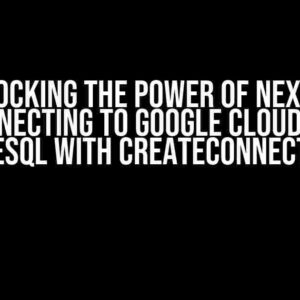Are you struggling to get your GCP Load Balancer to work with IAP (Identity-Aware Proxy) settings? You’re not alone! Many developers have reported issues with this seemingly straightforward combination. In this article, we’ll dive into the depths of this problem and provide you with a step-by-step guide to resolve the issue once and for all.
The Problem: GCP Load Balancer vs IAP
At first glance, it seems like a match made in heaven: GCP Load Balancer, a powerful tool for distributing traffic, and IAP, a robust security solution for controlling access. However, the reality is far from it. When you try to combine these two services, things start to fall apart. Your load balancer refuses to play nice with IAP, leaving you with a bunch of 502 errors and frustrated users.
So, what’s going on? To understand the issue, let’s take a closer look at how both services work:
GCP Load Balancer 101
A GCP Load Balancer is a managed service that helps distribute incoming traffic across multiple backend instances. It provides scalability, high availability, and improved responsiveness. Here’s a simplified overview of the load balancing process:
- Client sends a request to the load balancer’s IP address
- Load balancer receives the request and selects a backend instance based on the configured routing rules
- Request is forwarded to the chosen backend instance
- Backend instance processes the request and sends a response back to the load balancer
- Load balancer forwards the response to the client
IAP 101
IAP is a security service that controls access to your resources based on user identity. It uses authentication and authorization mechanisms to ensure that only authorized users can access your resources. Here’s a simplified overview of how IAP works:
- User sends a request to the IAP-protected resource
- IAP intercepts the request and checks the user’s identity
- If the user is authorized, IAP forwards the request to the backend instance
- Backend instance processes the request and sends a response back to IAP
- IAP forwards the response to the user
The Conflict: Load Balancer and IAP
Now that we’ve covered the basics of both services, let’s see what happens when we try to combine them:
+---------------+
| Client |
+---------------+
|
| (Request)
v
+---------------+
| Load Balancer |
+---------------+
|
| (Request)
v
+---------------+
| IAP |
+---------------+
|
| (Request)
v
+---------------+
| Backend Instance |
+---------------+
In this setup, the load balancer receives the client’s request and forwards it to IAP. IAP then checks the user’s identity and, if authorized, forwards the request to the backend instance. However, this is where things start to go wrong.
The load balancer is designed to distribute traffic, not handle authentication. When IAP intercepts the request, it expects the load balancer to forward the authenticated request to the backend instance. But the load balancer doesn’t understand IAP’s authentication mechanism, and it can’t forward the request properly.
This mismatch leads to a series of 502 errors, failed requests, and frustrated users. So, what can you do to resolve this issue?
The Solution: Configure IAP to Trust the Load Balancer
To make IAP and the load balancer work together harmoniously, you need to configure IAP to trust the load balancer. This involves creating an IAP-enabled backend service and specifying the load balancer’s IP address as a trusted proxy.
Here’s a step-by-step guide to get you started:
Step 1: Create an IAP-enabled Backend Service
In the Google Cloud Console, navigate to the Navigation menu ( three horizontal lines in the top left corner) and select **APIs & Services** > **Dashboard**. Click on **Enable APIs and Services** and search for **Identity-Aware Proxy API**. Click on the result and enable the API.
Once the API is enabled, create a new backend service:
gcloud compute backend-services create [BACKEND_SERVICE_NAME] \ --global \ --enable-iap
Step 2: Configure IAP Settings
Create an IAP settings file with the following content:
{
"identityAwareProxy": {
"enabled": true,
"oauth2ClientId": "[OAUTH2_CLIENT_ID]",
"oauth2ClientSecret": "[OAUTH2_CLIENT_SECRET]"
}
}
Replace `[OAUTH2_CLIENT_ID]` and `[OAUTH2_CLIENT_SECRET]` with the values from your OAuth 2.0 client ID and secret, respectively.
Step 3: Update the Load Balancer Configuration
Update the load balancer configuration to use the IAP-enabled backend service:
gcloud compute backend-services update [BACKEND_SERVICE_NAME] \ --global \ --iap-settings-file [IAP_SETTINGS_FILE]
Step 4: Add the Load Balancer’s IP Address as a Trusted Proxy
In the IAP settings file, add the load balancer’s IP address as a trusted proxy:
{
"identityAwareProxy": {
"enabled": true,
"oauth2ClientId": "[OAUTH2_CLIENT_ID]",
"oauth2ClientSecret": "[OAUTH2_CLIENT_SECRET]",
"trusted_proxies": [
"[LOAD_BALANCER_IP_ADDRESS]"
]
}
}
Replace `[LOAD_BALANCER_IP_ADDRESS]` with the load balancer’s IP address.
Step 5: Verify the Configuration
Verify that the load balancer and IAP are working together correctly:
gcloud compute backend-services describe [BACKEND_SERVICE_NAME] \ --global
Check the output to ensure that the IAP settings are correctly configured and the load balancer’s IP address is listed as a trusted proxy.
| Before | After |
|---|---|
|
|
With these steps, you’ve successfully configured IAP to trust the load balancer. Your users should now be able to access your resources without any issues.
Conclusion
In conclusion, the combination of GCP Load Balancer and IAP can be a powerful security solution for your resources. By configuring IAP to trust the load balancer, you can ensure seamless authentication and authorization for your users. Remember to follow the steps outlined in this article to avoid any potential pitfalls and ensure a smooth deployment.
If you’re still experiencing issues, don’t hesitate to reach out to the GCP support team or explore the official documentation for further guidance.
Happy deploying!
Here are 5 Questions and Answers about “GCP loadbalancer doesn’t work with IAP(Identity-Aware Proxy) settings”:
Frequently Asked Question
Get the answers to the most pressing questions about GCP loadbalancer and IAP settings!
Why doesn’t GCP loadbalancer work with IAP settings?
GCP loadbalancer and IAP settings can’t work together because IAP is designed to authenticate users, while loadbalancers are meant to distribute traffic. IAP settings will override the loadbalancer’s IP address, causing conflicts and making it impossible for the loadbalancer to function correctly.
Can I use IAP with an external loadbalancer?
Yes, you can use IAP with an external loadbalancer, but it requires some extra configuration. You’ll need to set up a proxy server between the external loadbalancer and the GCP backend service. This will allow you to authenticate users with IAP while still using the loadbalancer to distribute traffic.
What are the consequences of not using IAP with my loadbalancer?
Without IAP, your loadbalancer will be open to the public internet, making it vulnerable to unauthorized access and potential security threats. This can lead to data breaches, compromised user accounts, and a host of other security issues. So, it’s essential to implement IAP or another authentication mechanism to ensure the security of your resources.
Can I use a different authentication method with my loadbalancer?
Yes, there are alternative authentication methods you can use with your loadbalancer. For example, you can use Cloud Armor, which provides a web application firewall and DDoS protection, or Cloud CDN, which offers SSL/TLS encryption and authentication. However, keep in mind that IAP is the recommended authentication method for GCP resources.
How do I troubleshoot issues with IAP and my loadbalancer?
To troubleshoot issues with IAP and your loadbalancer, start by checking the IAP and loadbalancer logs for any errors or warnings. Verify that the IAP configuration is correct and that the loadbalancer is properly configured to use IAP. You can also test the loadbalancer without IAP to isolate the issue. If you’re still stuck, feel free to reach out to GCP support for further assistance.


